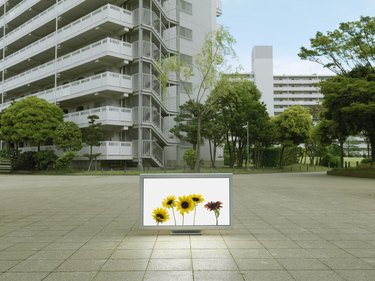
There are several reasons you might be seeing shadows on your TV, but the most common reason is burn-in. This occurs when you leave a still image on the screen for an extended period of time. There's no easy way to fix shadows caused by burn-in, so the best idea is to prevent it. If you haven't left a static image on the screen but you're still seeing shadows, your TV may be installed incorrectly.
Burn-In
Video of the Day
Burn-in occurs when you leave a still image, such as a paused DVD or menu screen, on your TV. The pixels inside the panel become damaged and develop a memory for the colors they are displaying. They begin to display only that color, developing a shadow of the still image even after you remove the image. Never leave your TV on a still image for more than half an hour, just to be safe. Plasma TVs, with their phosphor technology, are more susceptible to burn-in than LCD TVs that use liquid-crystal technology, especially during the first 200 hours of use. Avoid playing video games with static boxes, such as those that show your power levels, on plasma TVs if possible. Extended play can cause the static boxes to burn in. Also, stay away from the black bars that appear when watching a widescreen movie. Most DVDs give you an option to watch a full-screen version. If not, change the TVs aspect ratio through the picture menu until the black bars disappear. These bars can leave shadows along the entire top and bottom of the TV screen, or they may cause a dark line along the border of the black boxes.
Video of the Day
Wall Mount
If a television has been poorly mounted to a wall, shadowing may occur. Always follow the manufacturer's instructions when mounting your television to a wall. Do not angle the television more than 70 degrees in any direction, as doing so causes the weight of the television to shift, which may damage the pixels.
Mounting Stand
If you prefer to have your TV sit on the floor or on an entertainment center, always use the model's mounting stand. If you sit the TV directly on the floor or another surface, the weight of the TV could compress lower pixels, causing a shadow effect at the bottom of the screen.
3-D
If you're looking at a 3-D television, you may see a shadow effect on the image, especially if you aren't sitting directly in front of the TV. The 3-D technology used for many of these TVs still relies on the addition of special glasses to make the images clear with no shadowing.